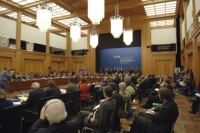ESA Council Meeting
5 December 2005
Objectives and priorities for Europe in space are being discussed at a Ministerial meeting in Berlin. On 5 and 6 December, the Ministers in charge of space activities within the 17 ESA Member States and Canada meet to deliberate on a plan for discovery and competitiveness for Europe in space, and to decide on the future programmes.
 |
|
Main Room, Conference Centre of the Foreign Ministry (Auswärtiges Amt), Berlin |
Ministers will therefore be invited to take decisions that will provide Europe and its citizens with a competitive space sector able to lead the search for new discoveries, guarantee access to strategic data and new services, and consolidate its share of the worldwide commercial market.
With that aim in mind, they will be invited to decide on the continuation of programmes in Space and Earth sciences, but also regarding launchers, Europe’s contribution to the International Space Station, and telecommunications; they will also be asked to embark on new activities, most notably a system for Global Monitoring for Environment and Security (GMES), space exploration, in particular with an exploration mission to Mars, and new technology programmes, especially in the fields of telecommunications, future launchers and in-orbit demonstrations.
These programmes taken together constitute a coherent set of activities, from launchers to satellites, from technology to development and from science to applications. The flexibility provided by optional programmes, which allows Member States to reflect their varying levels of interest in each individual programme, has to remain consistent with the coherence between the different programmes and activities. Only this way is it possible to meet the general objectives set for an efficient and successful European Space Policy.
Science and Basic activities: the Level of Resources 2006-2010
ESA programmes are split into two areas: Mandatory Activities and Optional Programmes.
The Mandatory Activities at ESA consist of the Scientific Programme and the Basic Activities (General Studies, Technology Research, Technology Transfer Programme and Earthnet, Education and Corporate/Administrative activities). They are implemented in 5-year funding slices. The next period is planned for 2006-2010, and decision on the following slice is to be taken before the end of the 3rd year.
ESA's Mandatory Activities are also the backbone of the Agency, building a highly skilled staff in science, technology, spacecraft operations, which are essential to the successful performance of ESA’s optional programmes. All the Member States contribute to the Mandatory Activities on a scale based on national income.
The Optional Programmes cover areas such as Earth observation, telecommunications, satellite navigation, space transportation systems (launchers), human spaceflight, microgravity and exploration. Member States are free to decide whether or not to participate, as well as the level of their financial involvement.
The Space Science Programme
European scientists have selected the scientific questions to be addressed in the long term by the Scientific Programme. They are collected in a coherent science and technology plan: Cosmic Vision. Cosmic Vision, from now until 2025, addresses four main questions which are essential if we are to understand the Universe and our place in it. Answers to these questions will be approached by addressing specific aspects of each general theme. The Science Programme missions already implemented or under implementation, and which contribute to the main themes and sub-themes, are also listed.
- What are the conditions for life and planetary formation?
- From gas and dust to stars and planets (ISO, HST, Herschel, Astro-F)
- From exo-planets to bio-markers (Hipparcos, GAIA, Corot)
- Life and habitability in the Solar System (all Solar System missions, in particular Giotto, Huygens, Cluster, Mars-Express, Rosetta, Double Star, Venus Express, BepiColombo)
- How does the Solar System work?
- From the Sun to the edge of the Solar System (Ulysses, SOHO, Cluster, Double Star, Solar-B, Solar Orbiter)
- The building blocks of the Solar System (Giotto, Rosetta, SMART-1, Chandrayaan-1 and planetary missions)
- What are the fundamental laws of the Universe?
- Exploring the limits of contemporary physics (Microscope)
- The gravitational wave Universe (LISA PF, LISA)
- Matter under extreme conditions (HST, JWST, Newton, INTEGRAL)
- How did the Universe originate and what is it made of?
- The early Universe (Planck)
- The Universe taking shape (Planck, HST, JWST)
- The evolving violent Universe (HST, JWST, Newton, INTEGRAL)
Thus, the set of themes is coherent with the present programme and forms its natural extension in the future.
The programme will move forward by asking for proposals for new missions. The timing of the issuance of the first call depends critically on the Level of Resources agreed by Member States at the Ministerial Council. If the buying power erosion started in 1995 is continued, a call for new proposals will be unlikely before 2008, unless major changes are made to the present programme.
International collaboration with non-European space agencies – including NASA and JAXA – is likely to be a key ingredient in the implementation of this programme. Russia, China and India are other partners, whose role is expected to increase in the future.
Details on the optional programme can be found by following the related link to the full ESA Information Note.

